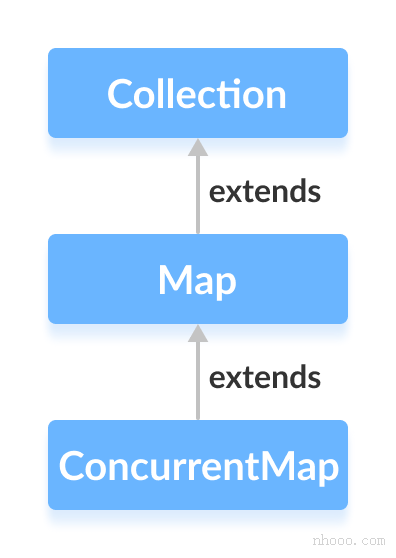Java 菜鸟教程
- Java 菜鸟教程
- Java 开发环境安装
- Java 入门程序
- Java JDK, JRE和JVM
- Java 基本数据类型
- Java 变量类型
- Java 运算符
- Java 输入和输出
- Java 表达式语句
- Java 注释
Java 流程控制
Java 数组
Java 面向对象(I)
- Java 类和对象
- Java 方法
- Java 构造函数
- Java 修饰符
- Java 字符串(String)
- Java this 关键字
- Java final 关键字
- Java instanceof 关键字
- Java 递归
Java 面向对象(II)
Java 面向对象(III)
- Java 嵌套和内部类
- Java 嵌套静态类
- Java 匿名类
- Java 单例模式
- Java 枚举(Enum)
- Java 枚举构造函数
- Java 枚举与字符串
- Java 反射(Reflection)
- Java 包(package)
Java 异常处理
- Java 异常(Exceptions)
- Java 异常处理
- Java throw和throws 关键字
- Java 处理多个异常
- Java try-with-resources
- Java 注解(Annotations)
- Java 日志(Logging)
- Java 断言(Assert)
Java 列表(List)
Java Queue(队列)
Java Map集合
Java Set集合
Java 输入输出(I/O)
Java Reader/Writer
Java 其他主题
Java ConcurrentMap 接口
在本教程中,我们将学习Java ConcurrentMap接口及其方法。
Java集合框架的ConcurrentMap接口提供了线程安全的映射。 也就是说,多个线程可以一次访问该映射,而不会影响映射中条目的一致性。
ConcurrentMap 被称为同步map。
它继承了Map接口。
实现ConcurrentMap的类
由于ConcurrentMap是接口,因此无法从中创建对象。
为了使用ConcurrentMap接口的功能,我们需要使用实现该接口的类ConcurrentHashMap。

如何使用ConcurrentMap?
要使用ConcurrentMap,我们必须先导入java.util.concurrent.ConcurrentMap软件包。导入包后,将按照以下方法创建并发映射。
// ConcurrentHashMap类的使用 CocurrentMap<Key, Value> numbers = new ConcurrentHashMap<>();
在上面的代码中,我们创建了一个名为numbers的ConcurrentMap。
这里,
Key - 用于关联map中每个元素(值)的唯一标识符
Value - map中与键相关联的元素
ConcurrentMap的方法
ConcurrentMap接口包含Map接口的所有方法。 这是因为Map是ConcurrentMap接口的超级接口。
除了所有这些方法,以下是特定于ConcurrentMap接口的方法。
putIfAbsent() - 如果指定的键尚未与任何值关联,则将指定的键/值插入到映射中。
compute() - 计算指定键及其先前映射值的条目(键/值映射)。
computeIfAbsent() - 如果键尚未与任何值映射,则使用指定函数为指定键计算一个值。
computeIfPresent() - 如果已使用指定值映射键,则为指定键计算新条目(键/值映射)。
forEach() - 访问map的所有条目并执行指定的操作。
merge() -如果指定键已经映射到某个值,则将指定的新值与指定键的旧值合并。如果键还没有映射,该方法将指定的值与键关联。
ConcurrentHashMap中ConcurrentMap的实现
import java.util.concurrent.ConcurrentMap;
import java.util.concurrent.ConcurrentHashMap;
class Main {
public static void main(String[] args) {
//使用ConcurrentHashMap创建ConcurrentMap
ConcurrentMap<String, Integer> numbers = new ConcurrentHashMap<>();
// 插入元素到map
numbers.put("Two", 2);
numbers.put("One", 1);
numbers.put("Three", 3);
System.out.println("ConcurrentMap: " + numbers);
//访问指定的键
int value = numbers.get("One");
System.out.println("被访问的值: " + value);
//删除指定键的值
int removedValue = numbers.remove("Two");
System.out.println("被删除的值: " + removedValue);
}
}输出结果
ConcurrentMap: {One=1, Two=2, Three=3}
被访问的值: 1
被删除的值: 2要了解更多信息ConcurrentHashMap,请访问Java ConcurrentHashMap。